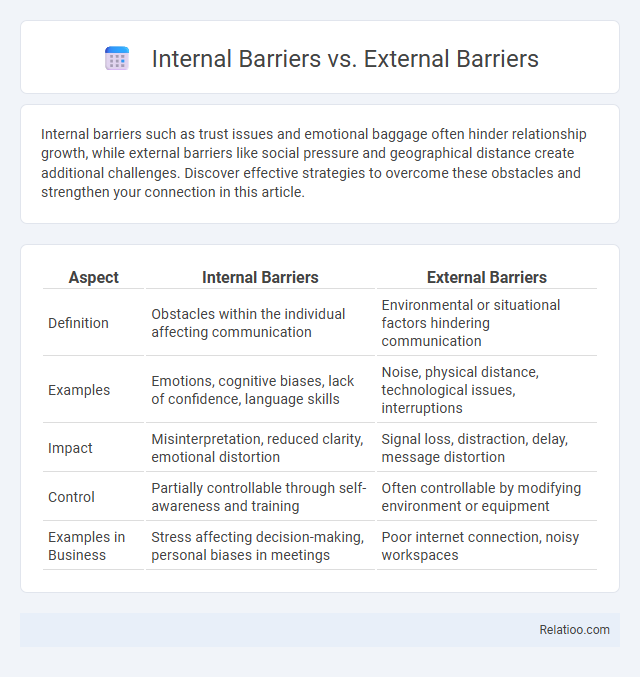Internal barriers such as trust issues and emotional baggage often hinder relationship growth, while external barriers like social pressure and geographical distance create additional challenges. Discover effective strategies to overcome these obstacles and strengthen your connection in this article.
Table of Comparison
| Aspect | Internal Barriers | External Barriers |
|---|---|---|
| Definition | Obstacles within the individual affecting communication | Environmental or situational factors hindering communication |
| Examples | Emotions, cognitive biases, lack of confidence, language skills | Noise, physical distance, technological issues, interruptions |
| Impact | Misinterpretation, reduced clarity, emotional distortion | Signal loss, distraction, delay, message distortion |
| Control | Partially controllable through self-awareness and training | Often controllable by modifying environment or equipment |
| Examples in Business | Stress affecting decision-making, personal biases in meetings | Poor internet connection, noisy workspaces |
Understanding Internal and External Barriers
Internal barriers to communication arise from personal factors such as emotions, attitudes, and cognitive biases that affect how you perceive messages. External barriers include environmental distractions, noise, and physical separations that hinder message transmission. Understanding these internal and external obstacles helps improve your ability to decode information accurately and enhances overall communication effectiveness.
Defining Internal Barriers
Internal barriers refer to psychological or emotional obstacles within an individual that hinder effective communication, such as stress, prejudice, or lack of attention. These barriers differ from external barriers, which involve environmental factors like noise or physical distance, and listening barriers, which specifically impede the process of receiving and interpreting messages accurately. Recognizing and addressing internal barriers is crucial to improving interpersonal communication and ensuring message clarity.
Defining External Barriers
External barriers refer to obstacles in communication originating outside the individual, such as environmental noise, physical distance, or technological malfunctions, which disrupt message transmission. Internal barriers, in contrast, are psychological or emotional factors within the listener, like stress, bias, or lack of attention, impairing message reception. Listening barriers encompass both internal and external factors that hinder effective auditory processing and understanding during communication.
Key Differences Between Internal and External Barriers
Internal barriers originate within your own mind, such as biases, emotions, or lack of attention, which impede effective listening and understanding. External barriers stem from the environment, including noise, physical distractions, or technical issues, that disrupt communication flow. Distinguishing these barriers helps you identify whether obstacles to listening are self-imposed or influenced by external factors, improving your ability to engage and respond accordingly.
Common Examples of Internal Barriers
Common internal barriers to effective communication include psychological factors such as stress, fear, and lack of confidence, which can distort your message or prevent you from fully engaging. Unlike external barriers like noisy environments or physical distance, internal barriers are rooted within personal attitudes, emotions, and cognitive biases. Listening barriers often stem from these internal obstacles, such as selective attention or prejudice, which hinder your ability to accurately receive and interpret information.
Common Examples of External Barriers
External barriers commonly include physical distractions such as noise, poor lighting, and uncomfortable environments that impede effective communication. Technological issues like faulty equipment or connectivity problems also contribute significantly to external communication disruptions. These obstacles contrast with internal barriers, which stem from individual psychological factors, and listening barriers, which involve problems in the active process of receiving and interpreting messages.
Impact of Internal Barriers on Personal Growth
Internal barriers, such as self-doubt, fear, and limiting beliefs, significantly hinder your personal growth by restricting your ability to process feedback and embrace new experiences. Unlike external barriers, which originate from the environment or social context, internal barriers are psychological obstacles that directly affect your motivation and emotional resilience. Overcoming these internal listening barriers enhances your capacity for effective communication, self-awareness, and continuous development.
Impact of External Barriers on Achievement
External barriers such as noise, physical distance, and environmental distractions significantly hinder effective communication by disrupting the transmission and reception of messages, ultimately reducing comprehension and achievement. These barriers create an obstructive environment that limits the listener's ability to focus, leading to misunderstandings and decreased productivity. Overcoming external barriers is crucial for enhancing listening skills and ensuring successful goal attainment in both personal and professional contexts.
Strategies to Overcome Internal Barriers
Internal barriers such as anxiety, lack of focus, and preconceived notions impede effective listening and communication more significantly than external barriers like noise or environmental distractions. Strategies to overcome internal barriers include practicing mindfulness to enhance concentration, actively engaging in empathetic listening to reduce biases, and utilizing mental summarization techniques to retain key information. Training in emotional regulation and building self-awareness further empower individuals to overcome internal obstacles and improve overall listening skills.
Strategies to Overcome External Barriers
External barriers to communication include environmental noise, physical distance, and technological disruptions that hinder message transmission. To overcome these challenges, you can utilize clear and reliable communication channels, ensure a quiet and controlled environment, and employ tools like noise-canceling devices or high-quality digital platforms. Implementing redundancy by repeating key information and encouraging feedback also helps mitigate the effects of external barriers.

Infographic: Internal Barriers vs External Barriers
 relatioo.com
relatioo.com